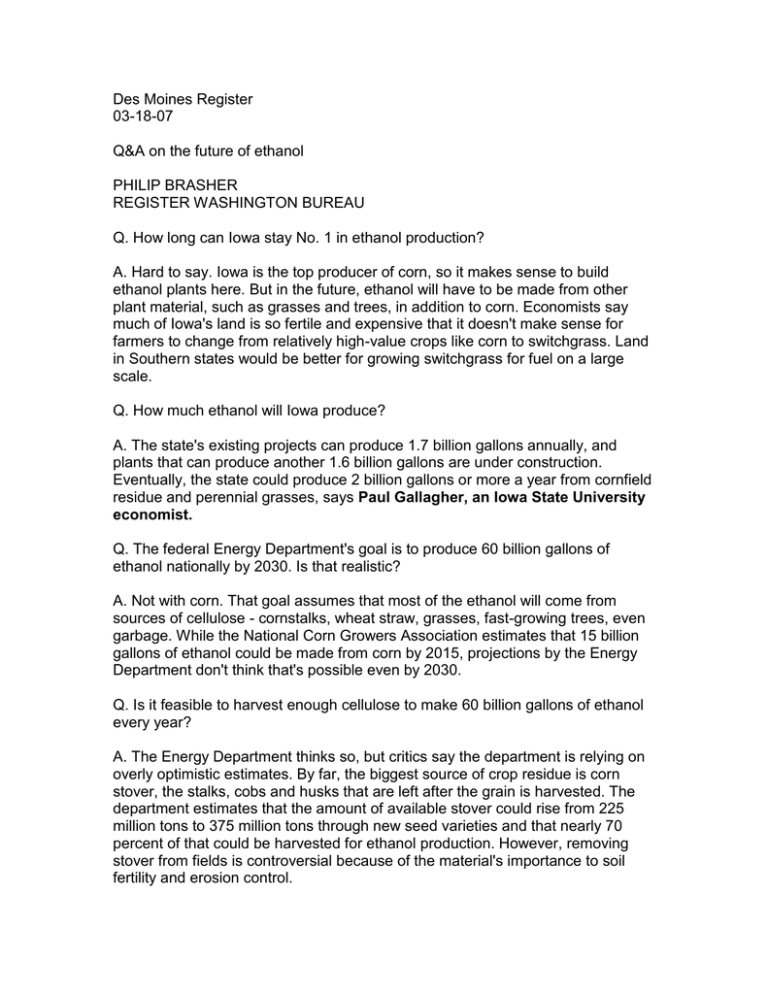Des Moines Register 03-18-07 Q&A on the future of ethanol
advertisement

Des Moines Register 03-18-07 Q&A on the future of ethanol PHILIP BRASHER REGISTER WASHINGTON BUREAU Q. How long can Iowa stay No. 1 in ethanol production? A. Hard to say. Iowa is the top producer of corn, so it makes sense to build ethanol plants here. But in the future, ethanol will have to be made from other plant material, such as grasses and trees, in addition to corn. Economists say much of Iowa's land is so fertile and expensive that it doesn't make sense for farmers to change from relatively high-value crops like corn to switchgrass. Land in Southern states would be better for growing switchgrass for fuel on a large scale. Q. How much ethanol will Iowa produce? A. The state's existing projects can produce 1.7 billion gallons annually, and plants that can produce another 1.6 billion gallons are under construction. Eventually, the state could produce 2 billion gallons or more a year from cornfield residue and perennial grasses, says Paul Gallagher, an Iowa State University economist. Q. The federal Energy Department's goal is to produce 60 billion gallons of ethanol nationally by 2030. Is that realistic? A. Not with corn. That goal assumes that most of the ethanol will come from sources of cellulose - cornstalks, wheat straw, grasses, fast-growing trees, even garbage. While the National Corn Growers Association estimates that 15 billion gallons of ethanol could be made from corn by 2015, projections by the Energy Department don't think that's possible even by 2030. Q. Is it feasible to harvest enough cellulose to make 60 billion gallons of ethanol every year? A. The Energy Department thinks so, but critics say the department is relying on overly optimistic estimates. By far, the biggest source of crop residue is corn stover, the stalks, cobs and husks that are left after the grain is harvested. The department estimates that the amount of available stover could rise from 225 million tons to 375 million tons through new seed varieties and that nearly 70 percent of that could be harvested for ethanol production. However, removing stover from fields is controversial because of the material's importance to soil fertility and erosion control. Q. That's a massive amount of material. How will it be transported and stored? A. Experts say that may be the biggest challenge of all. A typical ethanol plant would need the equivalent of 80 truckloads of stover every day of the year. (If the material isn't tightly packed, many more truckloads than that would be needed.) Delivering that much material to an ethanol facility within a short time after harvest, so that it can be stored properly to prevent decay, would be very difficult. Q. What does it take to make ethanol from cellulose? A. Cellulose is made of fermentable sugars just as corn is, but the cellulosic sugars are harder to get to. The cellulose must be pretreated with heat and acid to break it down. Then, special enzymes, such as those used to give blue jeans the faded look, and microorganisms are used to produce the sugars and then ferment them into alcohol.






